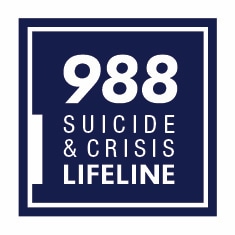Suicide and Occupation
Contact the 988 Suicide and Crisis Lifeline
- Call 988
- Use the online Lifeline Crisis Chat
Both are free and confidential. You’ll be connected to a counselor in your area.
For more information, visit the 988 Suicide and Crisis Lifeline
What is suicide?
Suicide is death caused by injuring oneself with the intent to die, and is a serious public health problem.
What do we know about the suicide problem?
In 2020, there were 45,979 deaths by suicide in the United States, which is about 1 suicide every 11 minutes.1 Suicide was the:
- 2nd leading cause of death among people 10 to 34 years of age
- 4th leading cause of death among people 35 to 44 years of age
- 7th leading cause of death among people 45 to 54 years of age
- 9th leading cause of death among people 55 to 64 years of age
Can occupation affect a person’s risk of suicide?
Many factors impact someone’s risk for suicide. Some occupations or jobs have higher rates of suicide than others.2-4
What factors are linked to increased risk of suicide for some occupations?
Among the factors thought to contribute to increased risk of suicide by occupation:
- Job factors–such as low job security, low pay and job stress4-6
- Access to lethal means–the ability to obtain things like medications and firearms4, 7
Other factors that can influence the link between occupation and suicide include: gender, socioeconomic status, economic climate, and societal norms.4-5, 7-8
What are ways reduce and prevent suicide in the workplace?
CDC’s Preventing Suicide: A Technical Package of Policy, Programs, and Practices provides several recommendations to reduce and prevent suicide. Many of these recommendations are relevant to the workplace, including:
- Increasing access to health and behavioral health care services
- Reducing access to lethal means among persons at risk of suicide
- Changing organizational polices and culture to promote a protective environment for workers, such as:
- Promoting prosocial behavior among employees (e.g., asking for help)
- Assessing and referring employees to helping services (e.g., mental health, substance abuse treatment, financial counseling)
- Developing crisis response plans for post-suicide events
- American Psychiatric Association Foundation (APA): Suicide Prevention
American Psychiatric Association Foundation provides a list of tools and resources to help employers and coworkers respond to the reality of suicide in the workplace. - National Action Alliance for Suicide Prevention: Workplace
Provides guidance on how to develop a comprehensive workplace suicide prevention program as well as 10 action steps for addressing the aftermath of suicide. - National Fallen Firefighters Foundation, Everyone Goes Home Life Safety Initiative
Provides prevention resources available for firefighters. The goal of the Everyone Goes Home® program is to reduce the number of preventable firefighter line-of-duty deaths and injuries. - Suicide Prevention Resource Center: Workplaces
Sponsored by a grant from the U.S. Department of Health and Human Services, Substance Abuse and Mental Health Services Administration, Center for Mental Health Services, this center provides many resources for the prevention of suicide in workplaces. - Workplace Strategies for Mental Health: Suicide Response
Provides information on how to respond to the suicide or attempted suicide of an employee. - World Health Organization (WHO) Preventing Suicide: A Resource at Work
WHO provides useful information on the warning signs and how to help a coworker who is showing signs of thinking about suicide.
- American Psychiatric Association (APA): Suicide Prevention
- American Psychological Association (APA): Suicide
- American Society of Safety Professionals (ASSP): Suicide in the Construction Industry
- CDC: National Violent Death Reporting System (NVDRS)
- CDC: Preventing Suicide: A Technical Package of Policy, Programs, and Practices
- CDC: Suicide Prevention
- CDC: Suicide Rising Across the US
- CDC: WISQARS™ (Web-based Injury Statistics Query and Reporting System)
- National Institute for Mental Health (NIMH): Suicide Prevention
- OSHA: Preventing Suicides in Construction
- Substance Abuse and Mental Health Services Administration (SAMHSA): Suicide Prevention
- U.S. Department of Veterans Affairs: Suicide Prevention
- Suicides Among First Responders: A Call to Action
- Envisioning the Future of Construction: Challenges and Opportunities for Occupational Safety and Health
- Partnering to Prevent Suicide in the Construction Industry – Building Hope and a Road to Recovery
- Suicide Risk for Veterinarians and Veterinary Technicians
- Injured Workers More Likely to Die from Suicide or Opioid Overdose
- Job Strain, Long Work Hours, and Suicidal Thoughts
- Suicide Among Former NFL Players
- Workplace Suicide
- Stress and Health in Law Enforcement
- NIOSHTIC-2 is a searchable bibliographic database of occupational safety and health publications, documents, grant reports, and journal articles supported in whole or in part by NIOSH.
- NIOSHTIC-2 search results on Suicide are based on keywords related to suicide.
References
- CDC [2020]. Leading cause of death by age group. National Vital Statistics System, National Center for Health Statistics, National Center for Injury Prevention and Control, WISQARS™.
- CDC [2018]. Suicide rates by major occupational group–17 states, 2012 and 2015. MMWR 67(45):1253–1260.
- Tomasi SE, Fechter-Leggett ED, Edwards NT, Reddish AD, Crosby AE, Nett RJ [2019]. Suicide among veterinarians in the United States from 1979 through 2015. J of Am Vet Med Ass. 254(1):104-112.
- Milner A, Spittal MJ, Pirkis J, LaMontagne AD [2013]. Suicide by occupation: Systematic review and meta-analysis. Br J Psychiatry 203(6):409-416.
- Milner A, Witt K, LaMontagne AD, Niedhammer I [2018]. Psychosocial job stressors and suicidality: A meta-analysis and systematic review. Occup Environ Med 75(4):245-253.
- Choi BK [2018]. Job strain, long work hours, and suicidal ideation in US workers: A longitudinal study. Int Arch Occup Environ Health. 91(7):865-875.
- Milner A, Witt K, Maheen H, LaMontagne AD [2017]. Access to means of suicide, occupation and the risk of suicide: A national study over 12 years of coronial data. BMC Psychiatry 17:125
- Milner A, Page K, Spencer-Thomas S, LaMontagne AD [2015]. Workplace suicide prevention: a systematic review of published and unpublished activities. Health Promot Int 30(1):29-37.

